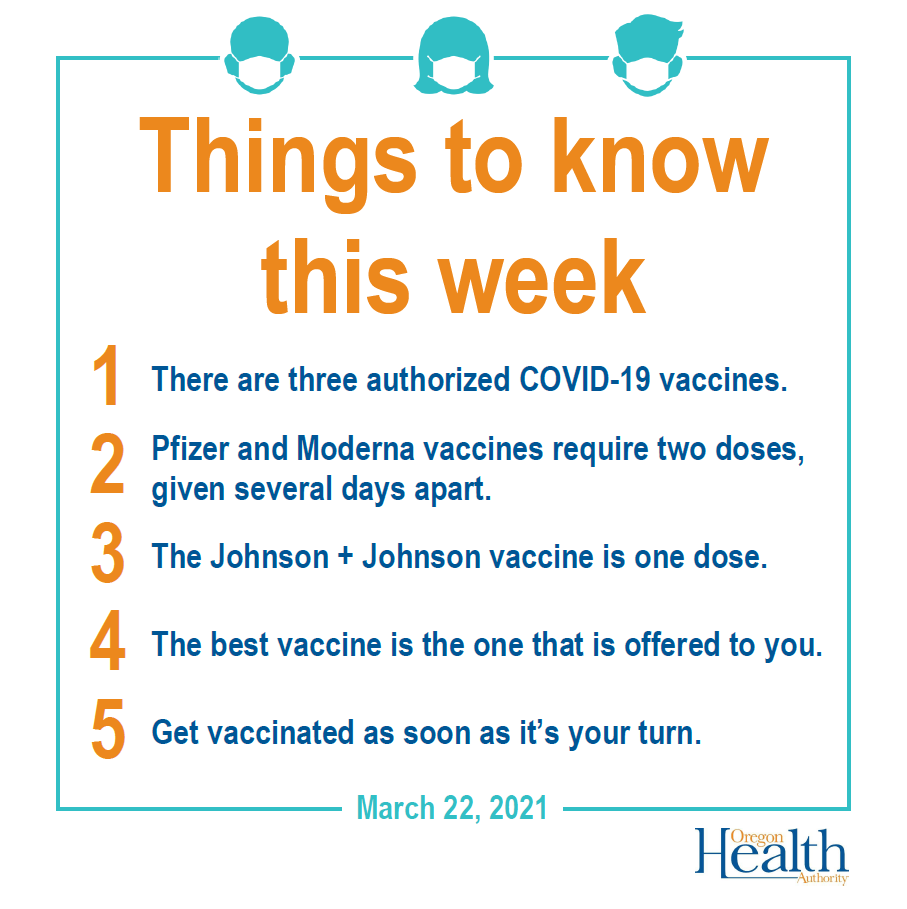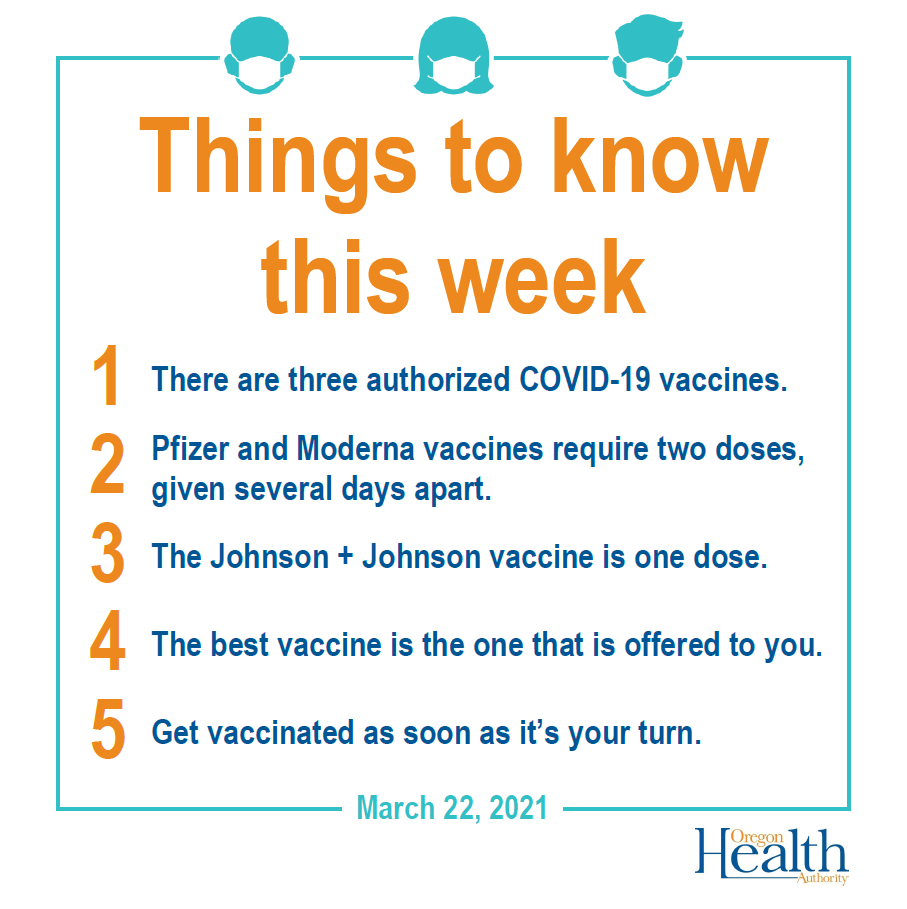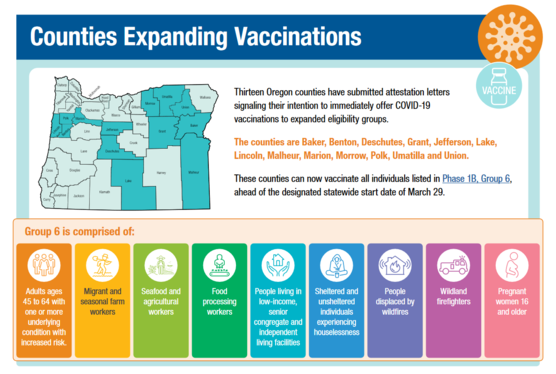There are two new COVID-19 related deaths in Oregon, raising the state’s death toll to 2,365, the Oregon Health Authority reported today March 22, 2021.
OHA also reported 178 new confirmed and presumptive cases of COVID-19, bringing the state total to 161,706.
The new confirmed and presumptive COVID-19 cases reported today are in the following counties: Benton (8), Clackamas (29), Columbia (3), Coos (8), Curry (8), Deschutes (6), Douglas (10), Jackson (6), Jefferson (2), Josephine (10), Klamath (9), Lake (1), Lane (16), Lincoln (1), Linn (4), Marion (23), Multnomah (24), Polk (1), Tillamook (4), Washington (2) and Yamhill (3).
Johnson & Johnson vaccine is another effective tool in our toolkit
You may be wondering about taking the Johnson & Johnson vaccine. This vaccine is one more tool in our toolbox. The more vaccines and options we have available, the faster everyone who can get vaccinated will have the opportunity.
The vaccine was highly effective at preventing hospitalization and death in people who did get sick. In addition, early evidence suggests that the J&J vaccine might provide protection against asymptomatic infection, which is when a person is infected by the virus that causes COVID-19 but does not get sick.
One advantage of the Johnson & Johnson vaccine is that it doesn’t have to be kept as cold as the Pfizer and Moderna vaccines. This makes it easier to transport and to store, which means it can be offered in more locations. This is especially important for people with limited transit options, those who may be leaving the state, as well as people who are home-bound.
Another advantage is that the Johnson & Johnson is a “one and done” vaccination with no second dose currently required. Getting protection with only one shot is helpful for people who may have difficulty returning for a second shot.
So what’s the best vaccine for you? The best vaccine is the one you can get. With three vaccines shown to be safe and highly effective, people in Oregon should take the shot they can, as soon as it’s available to them.
For more information on the Johnson & Johnson vaccine go to https://www.cdc.gov/coronavirus/2019-ncov/vaccines/different-vaccines/janssen.html.
13 counties approved to expand vaccinations
Today, the Oregon Health Authority announced that 13 Oregon counties had submitted attestation letters signaling their intention to immediately offer COVID-19 vaccinations to expanded eligibility groups.
The counties are: Baker, Benton, Deschutes, Grant, Jefferson, Lake, Lincoln, Malheur, Marion, Morrow, Polk, Umatilla and Union.
By attesting, these counties can now begin vaccinating all individuals listed in Phase 1B, Group 6, ahead of the previously designated statewide start date of March 29.
Group 6 is composed of:
- Adults ages 45 to 64 with one or more underlying condition with increased risk.
- Migrant and seasonal farm workers
- Seafood and agricultural workers
- Food processing workers
- People living in low-income, senior congregate and independent living facilities
- Sheltered and unsheltered individuals experiencing houselessness
- People displaced by wildfires
- Wildland firefighters
- Pregnant people 16 and older
The Get Vaccinated Oregon tool is being updated to accommodate this newly added population of people eligible for vaccination.
What is Race, Ethnicity and Language, Disability (REALD)?
When you see an Oregon health care provider for COVID-19 testing or treatment, your provider may ask questions about your:
- Race
- Ethnicity
- Language (such as your preferred language and interpreter needs)
- Disability (your ability to do things such as see, hear or communicate)
They might ask you these questions out loud or give you a questionnaire like this to complete.
It’s up to you whether you answer these questions. We hope you’ll answer them, so we can better serve you and all Oregonians.
- We want everyone to feel safe answering REALD questions. Your information is strictly confidential and will be treated as a confidential public health record.
- OHA does not include your personal information, like name or date of birth, when reporting COVID-19 cases or race/ethnicity information to federal agencies like the Centers for Disease Control and Prevention.
- Sharing your REALD data will not impact any benefits you receive from the state, like SNAP or Oregon Health Plan/CAWEM. This means your personal information will not be shared with other agencies, including immigration officials.
Your answers will help us understand who is most affected by diseases like COVID-19, so we can work with these communities and learn how best to support them. We can also make sure the resources we provide are culturally appropriate and easily accessed by the groups that need them.
To learn more about how your REALD information is important to Oregon’s efforts to end the pandemic, read our recent COVID-19 REALD Report. It explains the importance and benefits of REALD data and what your answers have told us so far about COVID-19’s effect on specific groups in Oregon. You can also learn more on the REALD website.
![]()
Vaccinations in Oregon
Today, OHA reported that 21,629 new doses of COVID-19 vaccinations were added to the state immunization registry. Of this total, 14,422 doses were administered on March 21 and 7,207 were administered on previous days but were entered into the vaccine registry on March 21. Cumulative daily totals can take several days to finalize.
Oregon has now administered a total of 757,970 first and second doses of Pfizer, 740,155 first and second doses of Moderna and 32,022 single doses of Johnson & Johnson COVID-19 vaccines.
To date, 901,485 doses of Pfizer, 902,200 doses of Moderna and 54,700 doses of Johnson & Johnson COVID-19 vaccines have been delivered to sites across Oregon.
These data are preliminary and subject to change. OHA’s dashboards provide regularly updated vaccination data, and Oregon’s dashboard has been updated today.
COVID-19 hospitalizations
The number of hospitalized patients with COVID-19 across Oregon is 116, which is four more than yesterday. There are 18 COVID-19 patients in intensive care unit (ICU) beds, which is four fewer than yesterday. The total number of patients in hospital beds may fluctuate between report times. The numbers do not reflect admissions per day, nor the length of hospital stay. Staffing limitations are not captured in this data and may further limit bed capacity. More information about hospital capacity can be found here.
Learn more about COVID-19 vaccinations
To learn more about the COVID-19 vaccine situation in Oregon, visit our webpage (English or Spanish), which has a breakdown of distribution and other information.




